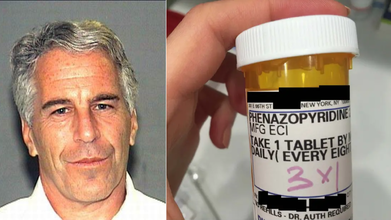- Health Conditions A-Z
- Health & Wellness
- Nutrition
- Fitness
- Health News
- Ayurveda
- Videos
- Medicine A-Z
- Parenting
Newly Discovered Tick-borne Virus In China Could Damage Your Brain

With the ongoing rise in different viruses, including mpox, Zika virus, etc., there is a new tick-borne disease called Wetland virus (WELV) discovered recently in China.
The Origin
In 2019, WELV previously infected a man in Inner Mongolia China, however, it was not identified until a new study was published in the New England Journal of Medicine last week.
The study says that a 61-year-old man who was bitten by a tick at a wetland park experiences "persistent fever and multiple organ dysfunction" and sought medical attention.
A team of Beijing Institute of Microbiology and Epidemiology researchers isolated the virus from that patient to find that it was WELV.
Signs and Symptoms
The team tested the virus and detected in 17 other patients in China. The symptoms included fever, headache, dizziness, muscle pain, fatigue, back pain, arthritis, swollen lymph nodes and neurologic issues.
Some also reported petechiae - spots on the skin caused by bleeding from capillaries.
What Is Wetland Virus?
The scientific name of this virus is Orthonairovirus which attacks humans through tick bites and causes problems in the brain.
This zoonotic virus is already present in animal species, wildlife, and livestock and now is an increasing concern towards human health.
What Does This Virus Do?
In lab mice, the study found that the brain got affected due to the virus and in humans fever, dizziness, headache, malaise, arthritis, back pain, and nausea are common symptoms.
Some people can also go into a coma and can experience high white blood cell count and fluid that can surround the brain and spinal cord. The virus can also damage tissues and cause blood clotting.
Prevention
Tick-borne diseases can transmit a wide range of viruses, some of which can cause severe conditions like hemorrhagic fever. While such cases are rare, they can be deadly, highlighting the need for vigilance.
Experts emphasise that the best way to prevent tick-borne illnesses is to protect against bites. The U.S. Centers for Disease Control and Prevention (CDC) advises avoiding areas where ticks thrive, such as wooded, grassy, or brushy environments. Ticks can also be found on animals.
To further protect yourself, the CDC recommends treating clothing and gear with 0.5% permethrin and using EPA-registered insect repellents, such as those containing DEET. After spending time outdoors, it's important to check for ticks on your clothing, gear, and pets, and showering within a couple of hours is advised.
Did Scientists Just Came Up With A New Blood Test That Detects And Monitors Lung Cancers In Real Time?

Credits: iStock
A team of researchers developed a novel blood test that could detect and monitor lung cancer in real time. They used the technique Fourier Transform Infrared (FT-IR) micro spectroscopy to detect a single lung cancer cell in a patient's blood. This technique combines advanced infrared scanning technology with computer analysis and focuses on the unique chemical fingerprint of cancer cells. The research has been lead by the team from University Hospitals of North Midlands NHS Trust or UHNM, Keele University, and Loughborough University.
Study's lead author Professor Josep Sulé-Suso, Associate Specialist in Oncology at UHNM, says, "This approach has the potential to help patients receive earlier diagnoses, personalized treatments, and fewer invasive procedures, and it could eventually be applied to many types of cancer beyond lung cancer."
How Does This New Blood Test Work?
Circulating tumor cells or CTCs are a type of cancer cell that can break away from a tumor and travel in bloodstream. They can also provide information on how the disease progresses and how well does a treatment work. CTCs are also the cells that leads to spread of cancer or what is known as metastases.
How is it novel and differ to the current methods in use? Current methods detect CTCs, but use a very complicated, expensive and time-consuming procedure. The current methods could also sometimes miss cancer cells altogether, as the cells often change their characteristics while circulating in the blood.
The researchers identify circulating tumor cells, or CTCs, in blood samples by directing a powerful infrared beam at them, similar in principle to the light used in a TV remote but much stronger.
Because different chemicals absorb infrared light in unique ways, CTCs produce a distinctive absorption signature, often described as a chemical fingerprint. Advanced computer analysis of this data can quickly determine whether tumor cells are present in the bloodstream.
Published in the journal Applied Spectroscopy, the method is both simpler and more cost-effective than current techniques. It uses standard glass slides already common in pathology laboratories, which could make it easier to incorporate into routine clinical use.
The team plans to test the approach in larger patient populations, with the goal of developing a fast, automated blood test that can be seamlessly added to cancer care pathways.
How Common Is Lung Cancer?
As per the World Cancer Research Fund, there were 2,480,675 new cases of lung cancer in 2022. The numbers have projected to rise significantly by 2050. Key drivers of lung cancer include tobacco usage, air pollution, and occupational exposure. There has also been a rise in lung cancer rates in women and seen disparities across regions.
What happens in lung cancer? The National Health Institute (NIH) notes that lung cancer refers to tumors originating in the lung parenchyma or within the bronchi. This is the third most common cancer in the US. Your cells divide and make more copies of themselves as a part of their normal function, however, they get mutations that cause them to keep making more of themselves when they should not. This is how damaged cells divide at an uncontrollable rate and create masses or tumor that keep your organs from working properly.
Epstein Files Photos Show A Bottle Of Phenazopyridine, Why We Think This UTI Medication Was There

Credits: Wikimedia Commons and House Oversight Committee
Epstein Files photos show someone holding a bottle of medication, which has come up in the latest batch of photos released on December 18 by House Oversight Democrats, as part of the 68 photos from Jeffrey Epstein's estate. On the bottle is a label with the word "Phenazopyridine". Why was this medicine there? What does it do?
What Is Phenazopyridine And Why We Think It Was Found At Epstein's House
Phenazopyridine is commonly used to reduce symptoms like urinary pain, burning, or feeling the urgency to pee. It is also used to treat bladder infections or urinary tract infection. WebMD says that it could also be used to help relieve symptoms from other causes like surgery or another procedure.
The Epstein files as we know are a body of documents that detail the criminal activities of American financier and convicted child sec offender, previously it had been reported that he allegedly paid doctors to medicate underage abuse victims. He would get doctors to prescribed anti-anxiety or anti-depressants medications, birth control pills, and also got the victims screened for sexually transmitted diseases, as HuffPost reports.
This is why we think he may have used this common UTI medication: Urinary Tract Infections or UTI are very common after sexual activities, especially for women. It is also because intercourse could push bacteria like E.coli from the genital area into the urethra, this could lead to infection. Since the urethra is shorter in women, it makes it easier for bacteria to reach the bladder. Furthermore, Phenazopyridine is also an over-the-counter, non-antibiotic method to prevent or reduce post-coital UTI frequency and could also eliminate the need for antibiotics.
Epstein Used Medicine To Drug His Victims
Previous reports too show how Epstein had used medicines to drug his victims. Virginia Giuffre told the Miami Herald that she was only 16 when she was recruited to give Epstein "massages". She revealed that she was prescribed Xanax, when she lived and traveled with Epstein for several years.
Another accuser Sarah Ransome said that when she told a doctor that she was sexually abused by Epstein, she was prescribed lithium.
What Do These Medicines Do To You?
Alprazolam, commonly sold under the brand name Xanax is used for anxiety and panic disorder. WebMD says that it produces a calming effect on the brain and helps reduce anxiety, while promoting relaxation. Reports show that he got a doctor prescribe these drugs so he would control the young women, and sedate them and induce amnesia of the abuse. Experts have noted that it can be used as a "date rape" or "grooming drug" because it makes users "zombie-like" or "dazed".
Lithium on the other hand, notes the National Health Service or NHS, UK, slows down the thinking and makes the people feel a bit "numb". Other side effects of lithium also include feeling tired or sleepy, along with lightheadedness, drowsiness, confusion, blackout, and difficulty speaking. This could also be used to control young victims.
Note: No reports have confirmed the use of Phenazopyridine found in Epstein estate as of now. This piece will be updated as and when there is any other information.
Super Flu Virus Update: 91 Flu Outbreaks In Canada, What Makes Subclade K Spread Rapidly, Explain Doctors

Credits: iStock
Super flu virus, or the new strain of H3N2 influenza is spreading and has affected a growing number of Canadians, reported the Global News. It is "increasing rapidly" around the country, warn experts. Health Canada confirmed that all regions of the country is affected by the growing influenza activity.
In the first week of December, Canada saw 6,799 cases of the flu with 91 outbreaks across the country. The number of positive tests also rose by 20.2 per cent as compared to the week before. Hospitalization numbers too have gone up with 3.6 hospitalization per 100,000 population, reported the Global News.
The strain causing a havoc in public health in Canada is the influenza A (H3N2) strain, which includes a subvariant A (H3N2) subclade K, noted the World Health Organization (WHO).
Who are hit the hardest? According to Health Canada's report, children are among those being hit hard, and most infections are detected in people under 19.
What Is The Super flu doing in Canada?
After the death of three children in Ottawa, between age five and nine, the health officials have urged anyone over the age of six months to get vaccinated. This means, the parents must step in now. In November, the Children's Hospital of Eastern Ontario, colloquially known as CHEO, also witnessed eight times more children tested positive for influenza as compared to the data of the same month from previous year. Hospitalized too doubled with children affected by flu.
Also Read: Is 2025 The Year Of Flu?
CHEO in a statement said, "The flu is more than a bad cold."
“Children under five are at a higher risk of severe illness from influenza because they have smaller airways, and their immune systems are still developing. Even healthy kids can become seriously ill, and flu spreads quickly in schools and child-care settings.”
Hospitals in Alberta too are seeing a flood of flu patients, this has jumped up to 70 per cent in a week. Dr Fahad Razak, internal medicine physician and professor at the University of Toronto told the Global News that 1 in 5 of all tests are being done are positive. "So that suggests we are right in the midst of that surge. The numbers could go higher."
Thanks to the holiday season and with increased travel, this will impact the surge in numbers, Dr Isaac Bogoch, Infectious disease specialist at Toronto General Hospital told the outlet, "It’s probably going to end up being a more severe and a more significant flu season compared to the average flu season."
Why Is This New Strain Hitting Hard?
Doctors explain that subclade K enhances the ability of the virus to slip through our immune protection. However, it does not mean that vaccination offers no protection against the flu. In fact, experts and doctors have been emphasizing the need to get yourself vaccinated to help you protect from the worst effects of the virus.
“If you look at deaths and severe illness with flu, the vast majority both in adults and in children are unvaccinated,” Razak said.
“Yes, you may get sick, even if you are vaccinated, it’s that the severity, the chance that you’re going to end up in hospital and worst-case scenario in the ICU or die does seem to be significantly protected against by being vaccinated.”
Health Canada too noted that vaccination can prevent anyone infected with influenza from developing any further complications.
Are Other Countries Impacted?
Apart from Canada, the UK and the US are also impacted by the superflu or the subclade K. In the UK the National Health Service (NHS) declared that the country is currently facing "worst case scenario" for December as flu hospitalization has surged by more than half in just one week. NHS in a statement last week said, on an average 2,660 patients were being hospitalized per day with flu last week. This is the higher ever for this time of the year with the surge being up by 55 per cent compared with the week before.
In the US, the Centers for Disease Control and Prevention (CDC) noted that infections are growing in 43 states.
© 2024 Bennett, Coleman & Company Limited

